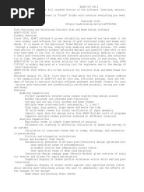Tr 43 Post Tensioned Concrete Floors Design Handbook

The Design of Post-Tensioned Concrete Flat Slabs in Buildings; Technical ReponNo 17'. Flat Slabs inPost-Tensioned Concrete with Particular Regard to theuse ofunbonded Tendons Design Recommendationu, Technical Report No 25', Post-Tensioned Flat-Slab Design Handbwk TR17 was a revision of TR8, and TR25 amplied the recommendations of TR17. Post-tensioning is the most versatile form of pre stressing, a technique which enables engineers to make the most effective use of the material properties of concrete, and so to design structural elements which are strong, slender and efficient.Post-tensioned concrete floors. A guide to design.
Funfair jingles app. S C O T TConcrete Society Technical Report No. 43 TR.043 Published 1994 ISBN 0 946691 45 2 Published by The Concrete Society No. 3, Eatongate Slough SL1 2JA Further copies may be obtained from Publication Sales, The Concrete Soaety QThe Concrete Society 1994 All rights reserved, except as permitted under current legislation. No part of this work may be photo- copied, stored in a retrieval system, published, performed in public, adapted, broadcast, transmitted, recordedorreproducedinanyform or byany means,withoutthepriorpermission ofcopyright owner.
Enquiries should be addressed to The Concrete Society. Although The Concrete Society (limited by guarantee) does its bestto ensure that any advice, reco-m- mendations or information ii may give either in this publication or elsewhere is accurate, no liability or responsibility of any kind(including liability for negligence) howsoever andfrom whatsoever cause arising, is accepted in this respect bythe Society, its servants or agents. CONCRETE SOCXET'II TECHNICAL REPORT POST-TENSIONED CONCRETE FLOORS - DESIGN HANDBOOK This TechnicalReport wasprepared by a Working Party oftheSociety's DesignGroup whichis one ofthespecialist technical groups within The Technical Development Cen:re. Members of the Working Party ME Rai i s (Convenor)ROW&Benaim and Asmiates MA.
PhD,CEng, MICE, MIStructE G A Bell BSc, CEng, MICE P W Matthew BE, MSc, MIE AusL RT Whitde MA(Cdnmb), CEn& MICE CCL Syslems Ltd Swift Smcrures Ltd Ove Arup and Partners ACKNOWLEDGEMENT Duringthedraftingofthisreporttheworkingpartyreceivedalargenumberofhelpful commenrrcfrommembers of theindustry. Assistanceinpreparationofthereport bythefollowingmembersofArupResearchand Development is gratefully acknowledged: Kate Benton, Ian Feltham, JonathanF~nch, Geoff Lavender, Paula Youngs. CONTENTS 1.Intmduction 1.1Advantages of post-tensioned floors 12Sltuctural types considered 1.4Bonded ar unbonded tendons 1.5Analytical techniques 2.1Effecrs of pascess 2.2One-way and two-wayspanning flmrs 2.3Flexure inone-wayflmrs 2.4-Flexure infIatslab (hvo-way r p n g )...

2.4.1Fkt slab critehi2:. 3.1Column layout 3 3 ':Floor i h i c b and types.:,.. ' 3 3,.?.Effect of reshaint tofloor shortening.:. 4.Materials 4.1Concrete 4.2Tenendons 4.2.1S m d4. How to change language in need for speed underground 1.